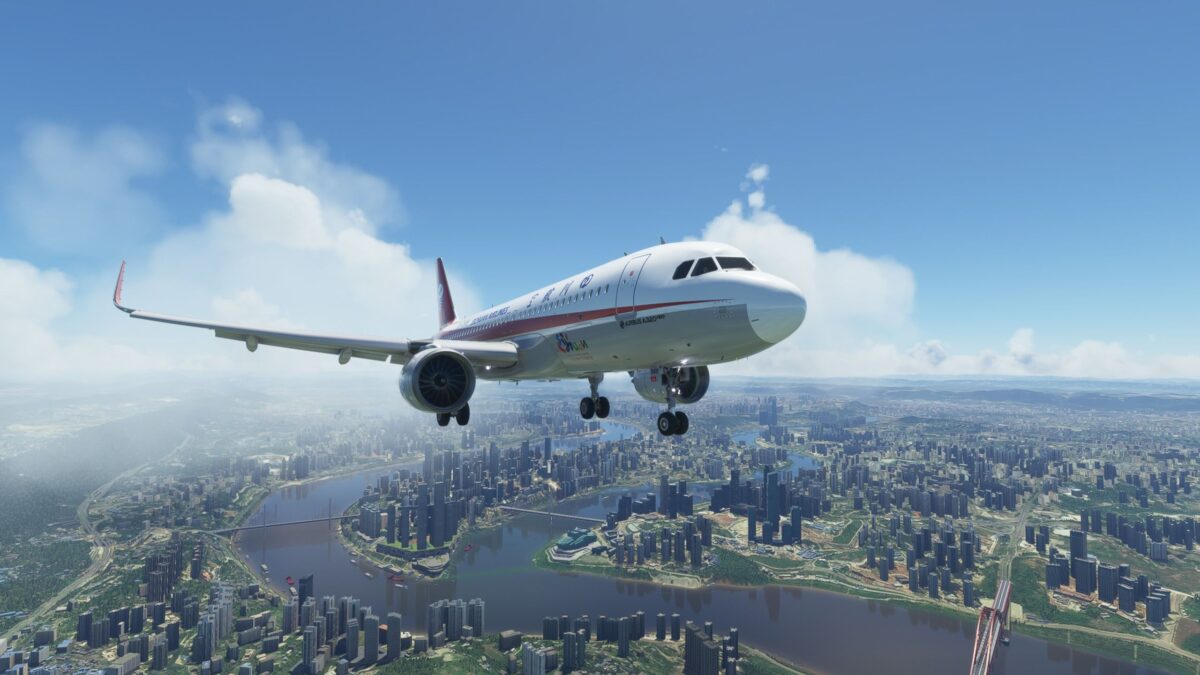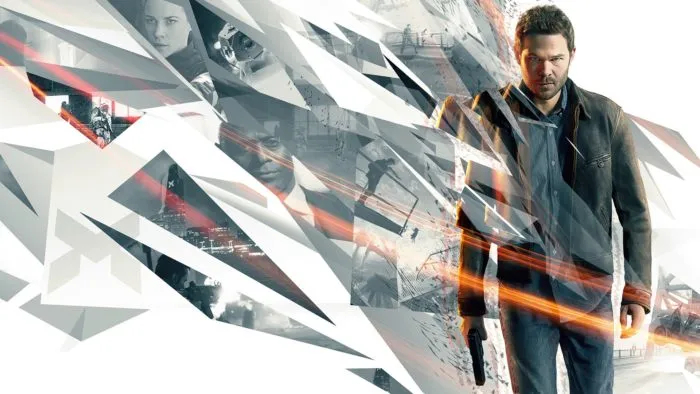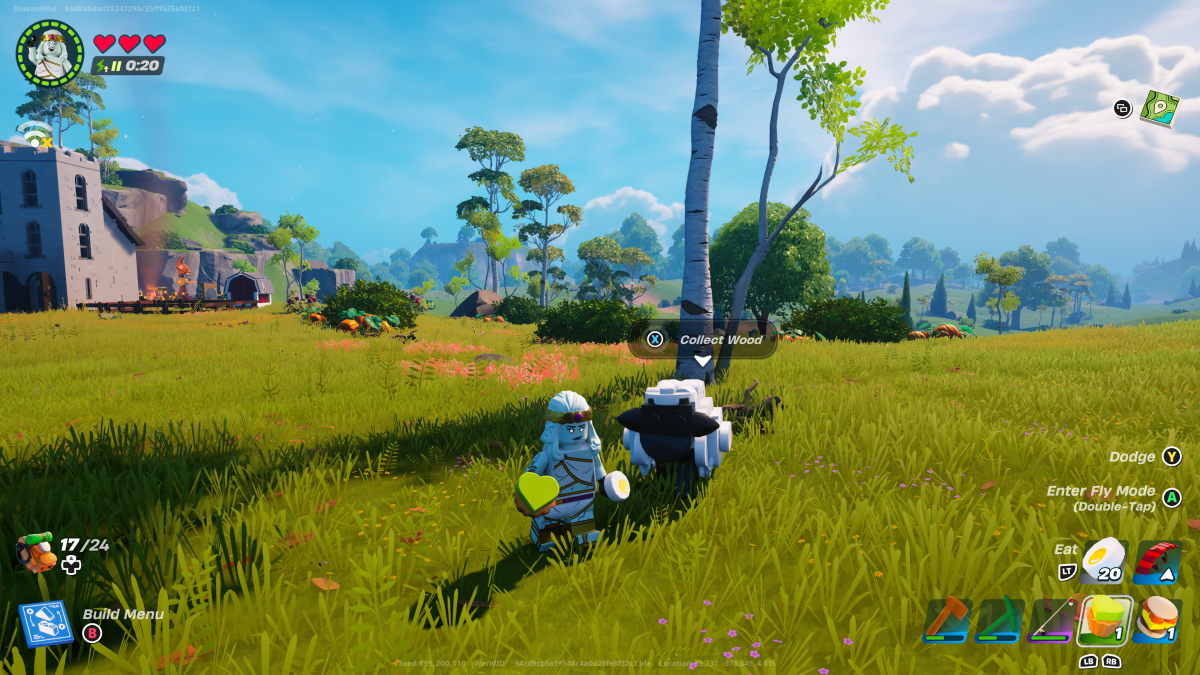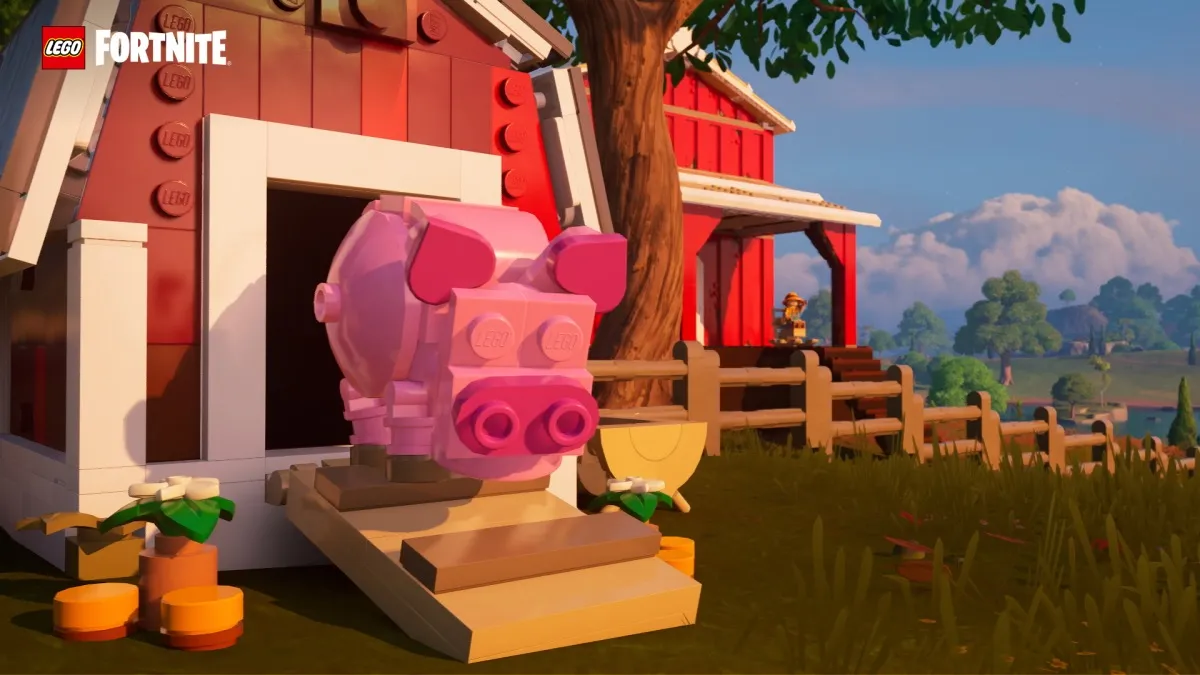Third-party developer SamScene3D recently released its “Chongqing Magic City 8D” add-on for Microsoft Flight Simulator, including both city scenery for the massive metropolis right in the heart of China and its Jiangbei International Airport (ZUCK).
As one of China’s most relevant emerging megalopolis, this is certainly an interesting location, with a mix of ultra-modern skyscrapers and traditional buildings that survived its urbanization. It’s also located pretty much in the middle of the country, making it a valuable destination if you like to fly in China.
On top of that, its location is extremely scenic. The city’s center features the confluence of the Jialing river into the massive Yangtze, and it’s surrounded by mountains and hills basically on all sides.
Last, but not least, the southern approaches to Runway 02L, 02R, and 03 fly right over the downtown area and the confluence of the rivers, creating really fetching vistas from the cockpit and bypassing the biggest problem that often affects city add-ons. In many cases, they’re so far from the main airports that those who fly airliners simply can’t enjoy the improved scenery. This is definitely not the case here, as there’s plenty to look at while landing and taking off on your Airbusses and Boeings.
If you’d like to see what the scenery looks like with your own eyes, above you can check out a video showcasing the ILS Z approach and landing on Runway 02L (both during the day and at night). The video below includes a full flyover of the airport and city itself, in a variety of lighting and weather conditions.
The add-on is available on SamScene3D’s own store for $16.99. Installation simply requires unzipping the scenery folder into your Community one, and the developer is proactive in communicating updates to its customers via email.
Before we go into the details about the quality of the scenery itself, we should likely talk about what you’ll find in the area in Microsoft Flight Simulator’s default scenery
The simulator usually does a good or even great job in turning the data provided by Bing into workable scenery that can be extremely beautiful in most parts of the world. China is one of the exceptions.
Unsurprisingly, there are government regulations in place restricting what can be displayed on mapping services and what kind of aerial imagery is made available overseas. This means that the imagery that Bing has access to isn’t just extremely outdated (and we’re talking about years here), but also of abysmal quality.
Due to the old data, the simulator portrays the main terminal of the airport as under construction, and runway 03/21 is completely missing. When the satellite imagery was shot, its construction hadn’t even started.
The quality is so bad that the algorithm didn’t even recognize that an airport is there besides the two older runways. No functioning taxiways, gates, or ramps have been included, and those are simply (badly) painted on the ground alongside the aircraft. The simulator likely didn’t understand that the imagery portrayed an airport’s apron, so it didn’t know it had to tidy things up.
Don’t get me wrong, I’m not knocking Microsoft Flight Simulator. Unfortunately, even its advanced automatic scenery generation algorithms can’t cope with the insufficient data available in many locations of central China, away from the coasts.




Usually, I put the comparison between default scenery and the add-on at the end of a review, but it’s pertinent to have it here. You can see it above with the default scenery on the left and SamScene3D’s add-on on the right.
You can easily notice that the difference is absolutely like night and day. On my PC (RTX 3070, Ryzen 9 3900x, 32 GB RAM), I lose 10-15 frames-per-second at 1440p resolution and Ultra detail settings, but considering what the add-on brings to the table, that’s entirely justified and worth it.
Of course, the default representation of the city isn’t much better than the airport. There isn’t a single bespoke landmark and 95% of the skyline is completely missing. Even on this side, SamScene3D’s add-on improves things radically.
Now, let’s move on to what this add-on actually offers. The airport is described as a bonus and a “simple” representation, that being said, it’s still quite competent and entirely workable.
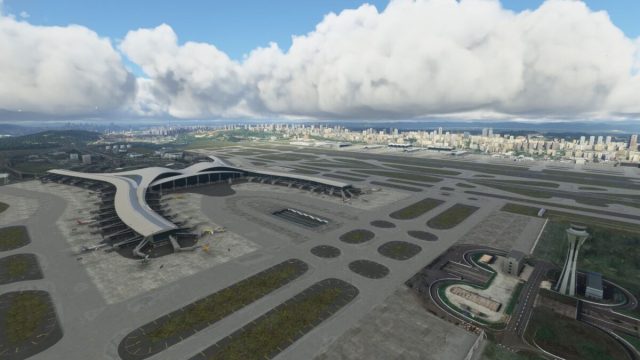
You shouldn’t expect quality comparable to the best stand-alone payware airports, but it’s still solid work. It includes all runways (while the colors of the tarmac aren’t 100% accurate), the taxiways and aprons are correctly represented, and the terminals and hangars feature decent modeling and textures.
There certainly are flaws, like the weird parallax shaders in some of the windows dangerously close to the jetways (which use default models), alongside some of the opaque textures used on other windows where the interiors aren’t modeled, which aren’t exactly top-notch.
Yet, there are also elements of brilliance. For instance, the terminal interiors that are modeled are quite well made and feature rather realistic crowds of passengers, which look very nice and convincing from the aprons. Even many of the top-notch stand-alone airports out there feel very much underpopulated, but this done does not.
If an airport featuring this level of quality was sold for $17 on its own, I’d probably not be completely satisfied, but for something marketed as a bonus of a whole city package within that same price, I can certainly accept a workable airport that isn’t exceptional, even more so since SamScene3D’s bonus airports have been consistently improving with each add-on released.
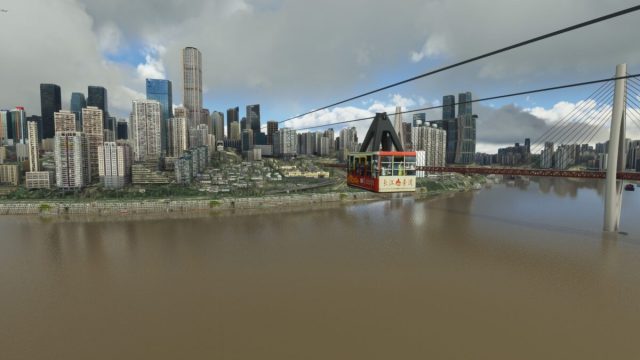
Speaking of “workable,” the approaches to runways 20 R and L and 02 R and L all work correctly (they were launched with an ILS offset issue but the developer quickly patched them) with their own SIDs and STARs. The new 03/21 runway, unfortunately, lacks all procedures, but this is due to the fact that Microsoft Flight Simulator does not recognize it.
Its approaches are available if you use Navigraph, but have to give up the SIDs and STARs due to an incompatibility created when Microsoft Flight Simulator doesn’t recognize a runway featured by Navigraph. Several third-party airports that had new runways built recently suffer from this issue, and it’s likely on Asobo’s side to solve. Hopefully, they’ll work out a method for timely updates before long.
Taxiways are correctly labeled so the default ATC can provide useful guidance to and from the gates, and even AI aircraft have no issues navigating the airport. The PAPI lights are all working and useful for visual approaches, so I’d judge the airport operationally solid, at least in relation to what SamScene3D can do and doesn’t need to be fixed directly by Microsoft.
Moving on to the city, the developer did a really good job in populating the skyline with literally hundreds of highrise buildings, from commercial skyscrapers to the iconic apartment complexes that are the symbol of modern Chinese megacities.
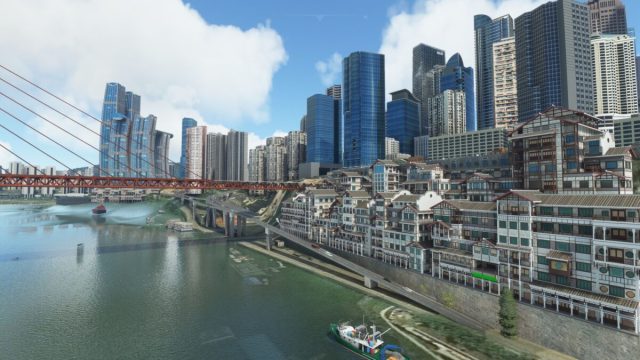
On a macro-level, the abysmal default representation of the city is certainly fixed, making landings and take-offs from the airport much more immersive and realistic.
Another highlight are the city’s many bridges. Considering that Chongqing is built across two major rivers, its bridges are extremely relevant to making it recognizable, and SamScene3D didn’t disappoint here either.
We can also see many smaller but interesting details that add flavor to the scenery, including the amusement park, the Grand Theatre, the old-style Hongyadong, the Great Hall of the People, and the animated elevated metro and cable car crossing the Yangtze river.
A lot of work has gone into painstakingly reproducing the most recognizable angles of the city, and even if not all textures are top-notch, they’re certainly good enough for the distance you’ll usually observe them from.
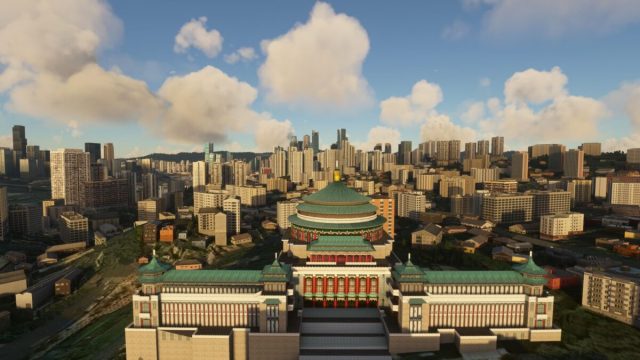
Unfortunately, the ground textures aren’t as good. The scenery retains the default orthoimagery which is low in detail and badly discolored. That being said, I wouldn’t blame the developer for this. Even assuming that better orthoimagery exists (and that’s not a safe assumption at all), replacing it for a city as big as Chongqing would likely be extremely memory-intensive and probably not worth it.
The default digital elevation map also comes with plenty of artifacts and bumps, so much that some of the buildings are pretty much floating in the air. Luckily, this isn’t very visible when you’re in flight. Yet, I wonder if smoothing things out at least to an extent could be possible in a future update.
The many small docks and piers that dot the banks of the rivers are also a bit disappointing. Most are portrayed simply by orthoimagery and partly or completely submerged. I’m quite positive that some level of improvement to liven up the river banks is possible, and hopefully, SamScene3D will consider it down the line. The developer is known for actively updating its packages, radically improving them over time, so there certainly is hope.
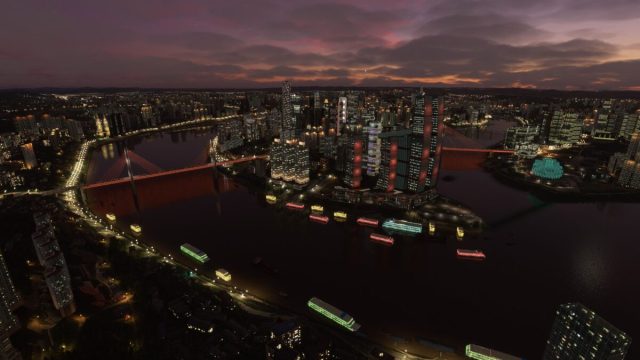
The scenery reacts well to weather including rain and even snow. Coverage on snowy days is basically perfect in the city and the airport isn’t too bad either, albeit a bit uneven.
Night lighting is also good, making the skyline particularly fetching after dark, even more so when you look at the skyscrapers’ reflections on the rivers. On the other hand, the opaque windows of the terminal buildings of the airport could use some more work as their lower-resolution textures stand out even more when lit.
Ultimately, while not perfect, this add-on improves Chongqing and its airport to such a radical extent that it’s impossible not to recognize its value, even more so considering the disastrous default scenery the developer had to work on top of.
Ultimately, if you plan to fly in the area, this add-on is pretty much required. I can’t even imagine simulating any kind of flight operation to or from Chongqing to any acceptable standard without having it.
- Very good representation of Chongchin's skyline.
- Plenty of small details to explore.
- Good night lighting.
- Workable airport included in the price.
- A massive improvement over the disastrous default scenery.
- Very scenic location and approaches right over the city's skyline.
- Not all textures are great.
- The banks of the rivers are a bit disappointing.
- Many bumps in the digital elevation map could use smoothing out.

